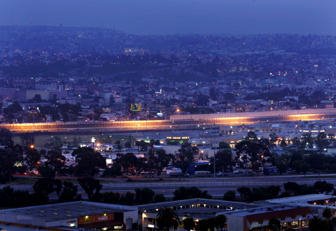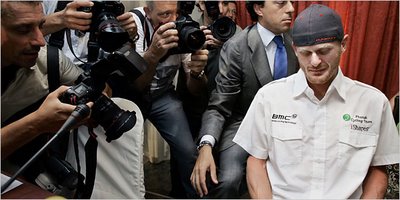 Sebastien Bourdais receives the Bridgestone Pole Award from Al Speyer - Photo Credit: Lesley Ann Miller, USA LAT Photographic - Copyright © 2006 Champ Car World Series, LLC.
Sebastien Bourdais receives the Bridgestone Pole Award from Al Speyer - Photo Credit: Lesley Ann Miller, USA LAT Photographic - Copyright © 2006 Champ Car World Series, LLC.It wasn't as if AJ didn't try to grab the pole. In the morning practice session, he scrubbed a wall and had to have repairs made to his car.
In qualifying, Tracy was the first one to post a competitive time. After that, Bourdais grabbed the pole then came along Allmendinger, but that time wasn't to remain.
Excerpts from CCWS -
CHAMP CAR WORLD SERIES POINTS LEADER SEBASTIEN BOURDAIS TAKES GRAND PRIX OF DENVER POLE WTH NEW TRACK RECORD
by Eric Mauk - CCWS
DENVER(August 12, 2006) - The Grand Prix of Denver Sponsored by Bridgestone has been the private playground of Newman/Haas Racing over the last four years as the Illinois-based team has won in each of its last three starts in Denver, winning two of those races from the Bridgestone Pole Position.
Things were no different on a cloudy Saturday in the Mile High City as NHR star Sebastien Bourdais (#1 McDonald's Ford-Cosworth/Lola/Bridgestone) used a dominant performance to earn his sixth Bridgestone Pole Position by setting a new track record around Denver's 1.657-mile street circuit. Bourdais needed just three laps to assume the pole, seemingly put it out of reach on his sixth pass, then cemented himself in the top spot with a new circuit standard of 59.096 seconds (100.941 mph) on his 15th and final lap of the day.
The pole was the sixth of the year for the Bridgestone Presents The Champ Car World Series Powered by Ford points leader and the 24th of his four-year series career. It is his second Denver pole and the third in four years for the Newman/Haas squad, the other coming courtesy of Bruno Junqueira (#2 Hole In The Wall Camps Ford-Cosworth/Lola/Bridgestone) in 2003. The pole win also gave Bourdais another championship point, widening his series lead to 32 over second-placed Justin Wilson (#9 CDW Ford-Cosworth/Lola/Bridgestone).
Bourdais will be joined in the front row by first-round qualifying leader A.J. Allmendinger (#7 Indeck Ford-Cosworth/Lola/Bridgestone), who was one of the few drivers to use the standard Bridgestone Potenzas in posting his top qualifying time., Allmendinger put up his best time on the regular Bridgestone tires, stopping the clocks at 59.350 seconds (100.509 mph) on his sixth trip around the Denver course. His Forsythe Championship Racing squad bolted on his last set of red-walled Potenzas for a second stint, but the Californian settled for second after being unable to run down the streaking Bourdais.
Wilson ended up third on the day, vaulting into the top three on his second set of tires, getting around the nine-turn layout in 59.878 seconds (99.623 mph). He took the third spot ahead of 2005 polesitter Paul Tracy (#3 Indeck Ford-Cosworth/Lola/Bridgestone) and Alex Tagliani (#15 Aussie Vineyards Ford-Cosworth/Lola/Bridgestone), who were the only other drivers in the field to break the one-minute mark in final qualifying.
Tracy rebounded from an incident in first-round qualifying to snare the fourth position on the grid, carding a time of 59.903 seconds (99.581 mph). The Canadian star was one of the first drivers on track when the emerald banner waved over Saturday's final round of qualifying and held the pole briefly after posting his best time on his sixth orbit of the Denver track. But despite the fact that he used each of his 15 qualifying laps for one of the few times all year, he was unable to improve on his second stint.
Team Australia's Tagliani earned his best starting position of the year after a lap of 59.919 seconds (99.554 mph) netted him the last spot in the top five. The veteran had never started better than seventh in any of his previous four Denver starts, and his top-five grid position is his first since the 2005 Molson Grand Prix of Toronto.
Bourdais had already scored a time that would have been good enough to score the pole on his sixth lap, but the Frenchman decided that in this case, valor would trump discretion as he rolled off Pit Lane to protect his lead. He was moved to do so when Allmendinger bolted on the red-walled Potenzas for his final stint, but while the young American was unable to lower his time, Bourdais shaved more time off his best effort, establishing what will now stand as the Denver track record.
The end of the session did yield some excitement as spots six through 10 all changed hands in the waning moments. Sophomore Andrew Ranger (#27 MSR Houston Ford-Cosworth/Lola/Bridgestone) matched a season-best by taking the sixth spot on the grid, dropping Oriol Servia (#6 Gulfstream Ford-Cosworth/Lola/Bridgestone) and Mario Dominguez (#19 Sonny's Bar-B-Q Ford-Cosworth/Lola/Bridgestone) to eighth and ninth respectively, after the two veterans posted their best times of the day on their 15th and final laps of the day. Junqueira jumped into the seventh spot between Ranger and Servia while Nelson Philippe (#4 CTE Racing - HVM Ford-Cosworth/Lola/Bridgestone) rounded out the top 10.
The Champ Car rookie contingent struggled on the tricky Denver layout as the six members of the class of 2006 will all grid in the last three rows for Sunday's event. Roshfrans Rookie-of-the-Year points leader Will Power (#5 Aussie Vineyards Ford-Cosworth/Lola/Bridgestone) showed the way, and will start 11th after posting a time of 60.405 seconds (98.753 mph).
The fifth running of the Grand Prix of Denver Sponsored by Bridgestone will take place tomorrow, with 97 laps of racing beginning at 1:45 local time. The race can be seen live nationwide on SPEED, and fans can also follow all of the action via the Race Director feature on the official website of the Champ Car World Series, www.champcar.ws. Fans can see highlights from the first two rounds of qualifying for the Bridgestone Pole Position on SPEED tonight, in a 30-minute show that airs at 9 p.m. Eastern Time.
Read All - Plus Driver Quotes>>










